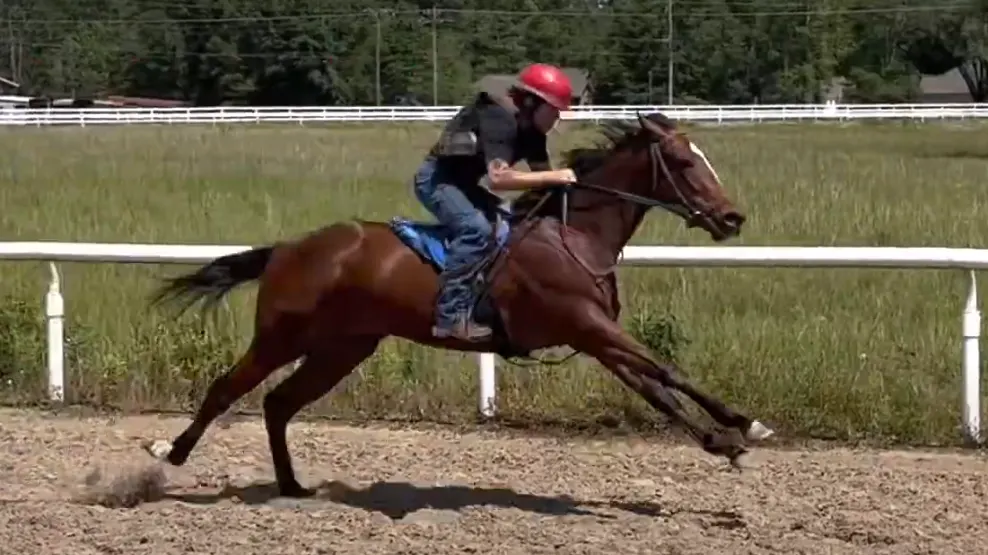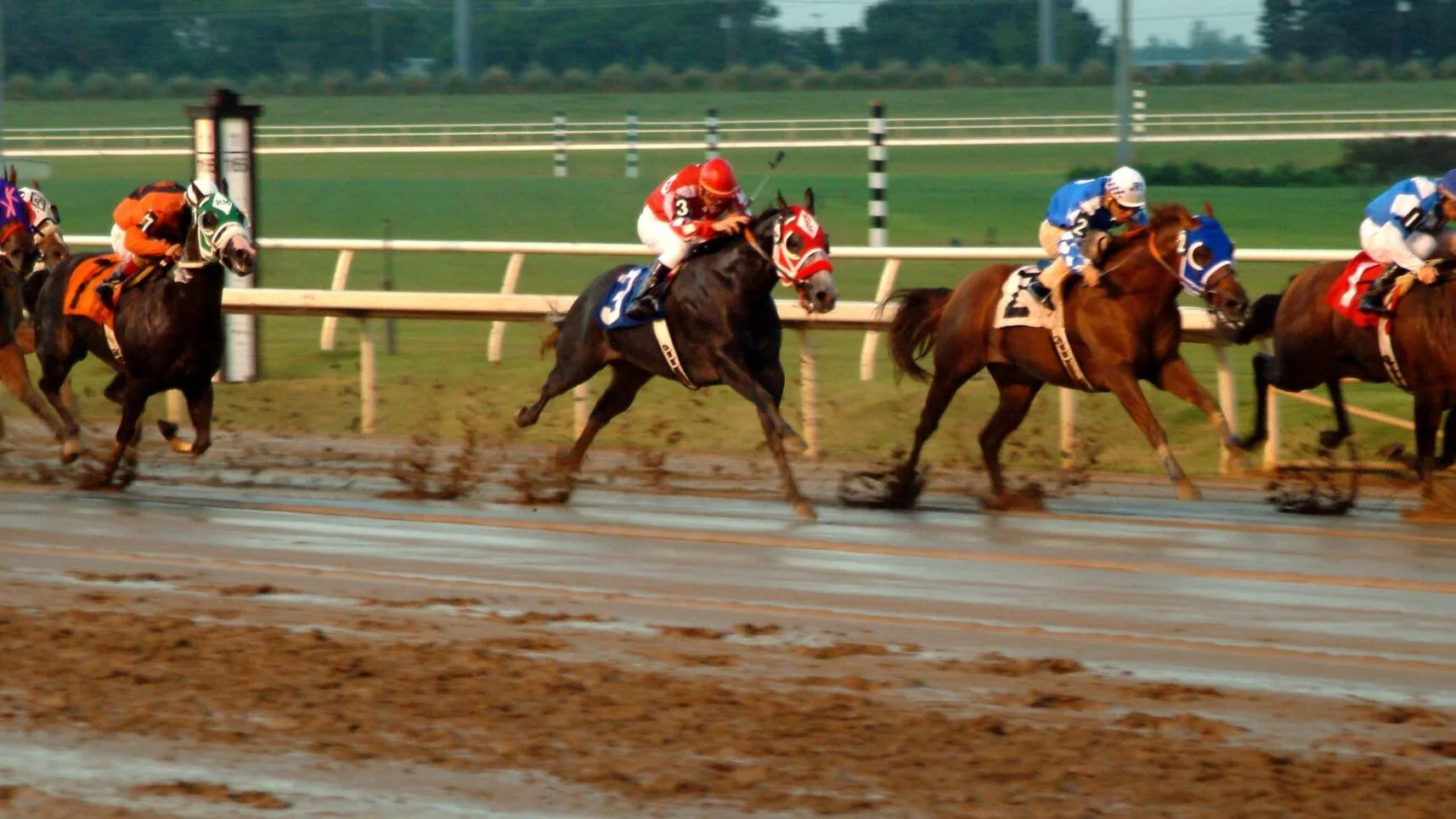Last updated: February 6, 2024
Did you know that the practice of whipping horses in racing has been a topic of debate for centuries? As an owner of six racehorses and a veteran in the horse racing industry for over 25 years, I’ve witnessed firsthand the evolution of this practice.
This article sheds light on why jockeys whip horses, providing clear and concise information from the perspective of someone deeply embedded in the sport. My goal is to demystify this aspect of horse racing, ensuring readers understand its purpose and the guidelines that govern it.

The Purpose of Whipping in Horse Racing
In horse racing, the use of the whip is a practice steeped in tradition and governed by strict regulations. Its purpose extends beyond mere encouragement of speed; it is a nuanced tool for communication and safety between jockey and horse.
Communication
- Whipping is a critical non-verbal communication tool for jockeys.
- It helps in guiding horses during the race, ensuring they stay focused and follow the intended path.
- This method signals the horse to increase speed or pay attention to the jockey’s commands.
Safety
- Whipping plays a vital role in maintaining safety on the track.
- It can prevent accidents by keeping the horse on course, especially in tight situations.
- Alerts horses to potential hazards, helping to avoid collisions with other competitors.
- Understanding the purpose of whipping from these perspectives highlights its importance in horse racing, balancing effective communication with the utmost safety for both horse and jockey.

Whipping and Horse Speed: Does It Make a Difference?
The impact of whipping on a horse’s speed is a topic of significant debate within the horse racing community. Here’s a concise exploration of the key points:
- Scientific Studies: Research on the subject presents mixed results. Some studies suggest that whipping does not significantly increase a horse’s speed, while others indicate it may have a short-term effect on performance.
- Expert Opinions: Veterinarians and equine behaviorists often highlight the stress and potential discomfort caused to horses by whipping, questioning its effectiveness and ethical implications.
- Psychological Impact: The psychological response of a horse to whipping can vary, with some horses potentially becoming desensitized over time, while others may experience increased stress or anxiety.
- Racing Strategies: Trainers and jockeys have differing views on the use of the whip, with some arguing for its necessity in guiding and motivating horses and others advocating for reduced reliance on physical cues.
- Animal Welfare Considerations: The debate also encompasses the welfare of the horse, with increasing calls for methods that prioritize the horse’s well-being while maintaining the competitive integrity of the sport.
Check out the YouTube video below; it provides a good perspective of how jockeys use whips in a race.
Guidelines and Regulations on Whip Use in Horse Racing
Horse racing authorities have established specific guidelines and regulations to ensure the welfare of horses while maintaining the competitive integrity of the sport. These rules focus on the humane use of whips and include:
- Limits on Use:
- There are strict limits on the number of times a horse can be whipped before and during the final stages of the race.
- These limits are designed to prevent overuse and ensure that whipping is only used when necessary for safety and communication.
- Whip Design:
- The design of whips used in racing is regulated to minimize pain and discomfort.
- Modern whips are padded, which helps to distribute the impact more evenly and reduce the risk of injury to the horse.
- Penalties for Misuse:
- Jockeys found to be in violation of these regulations face penalties, including fines and suspensions.
- These measures are in place to deter misuse and promote the ethical treatment of racehorses.
These guidelines and regulations reflect the industry’s commitment to animal welfare while recognizing the need for jockeys to communicate effectively with their horses during a race.

Ethical Considerations in the Use of Whips in Horse Racing
The use of whips in horse racing is a subject of ongoing ethical debate, balancing the traditions of the sport with modern concerns for animal welfare.
- Animal Rights Perspective:
- Animal rights groups argue that the use of whips can cause pain and stress to horses, advocating for reduced use or complete elimination.
- These organizations often call for alternative methods of horse and jockey communication that do not involve physical force.
- Industry Regulations:
- In response to these concerns, racing authorities have tightened regulations on whip use, emphasizing animal welfare.
- The introduction of padded whips and strict limits on their use during races are examples of efforts to address ethical concerns.
- The Role of Research:
- Ongoing research into the effects of whipping on horse behavior and physiology informs the debate, with some studies suggesting that regulated use may not cause harm.
- This research plays a crucial role in shaping regulations that protect racehorses while allowing the sport to continue.
- Balancing Tradition and Welfare:
- The challenge lies in balancing the historical aspects of horse racing with contemporary values of animal treatment.
- The industry seeks to find a middle ground where the sport can evolve to meet ethical standards without losing its essence.
This ethical debate underscores the importance of continued dialogue, research, and adaptation in the horse racing industry to ensure the humane treatment of racehorses while preserving the sport’s integrity.

Advances in Whip Technology
Recent advancements in whip design are at the forefront of addressing concerns about the potential discomfort or pain caused to horses during racing. These innovations aim to ensure that whips can be used effectively for communication without harming the animal.
- Padded Whips: Modern whips now come with padding that absorbs some of the impact, significantly reducing the risk of pain or injury to the horse. This padding ensures that the whip’s use is more about sound and sensation rather than causing discomfort.
- Regulated Design Specifications: Racing authorities have set strict specifications for whip design, including length, weight, and the type of material used. These specifications are intended to standardize whips to ensure they are used for guidance rather than punishment.
- Focus on Sensation Over Pain: The design of contemporary racing whips is focused on creating a noise or sensation that encourages the horse without causing pain. This approach allows jockeys to communicate their commands effectively, ensuring the safety and competitiveness of the race.
- Ongoing Research and Development: The horse racing industry continues to invest in research to further refine whip technology. This includes exploring materials and designs that can improve communication between jockey and horse while prioritizing animal welfare.
These technological advancements reflect the industry’s commitment to evolving practices in line with ethical standards and animal welfare considerations.

FAQs on Whipping in Horse Racing
Why do jockeys whip horses?
Jockeys whip horses as a form of non-verbal communication to guide them during races, ensure their safety by preventing accidents, and encourage them to maintain or increase speed, especially in critical moments of the race.
Does whipping make horses run faster?
The impact of whipping on a horse’s speed is a topic of debate. Some studies suggest that whipping does not significantly increase a horse’s speed, while others indicate it may have a short-term effect on performance. The effectiveness can vary based on the individual horse’s response.
What are the guidelines and regulations on whip use in horse racing?
Racing authorities have established specific guidelines that include strict limits on the number of times a horse can be whipped and the design of whips to minimize pain and discomfort. These rules are designed to ensure the welfare of horses while maintaining the competitive integrity of the sport.

Conclusion
In horse racing, the use of whips by jockeys is a practice rooted in the dual objectives of effective communication and safety, balanced against the backdrop of competitive racing. Innovations in whip design and stringent regulatory measures reflect the industry’s dedication to animal welfare, ensuring that the spirit of competition does not compromise the horses’ well-being.
The ongoing evolution of regulations and technology highlights a commitment to ethical practices, demonstrating that the industry is responsive to concerns about animal welfare while maintaining the integrity of the sport.
Call to Action: We encourage readers to engage with the topic by consulting additional authoritative sources and participating in informed discussions. This dialogue is crucial for the continuous improvement of ethical standards in horse racing.
Academic and Research Institutions
- Journal of Veterinary Behavior: Features studies on equine behavior and the impact of whip use in racing.
- Equine Veterinary Journal: Publishes research on horse health and welfare, including the effects of racing practices.
Industry Innovations
- Racing Equipment Manufacturers: Look for companies specializing in racing equipment to find information on the latest whip designs and technologies.
- Equine Science Centers: University-affiliated centers often conduct research on horse welfare and technology in sports, providing valuable insights into current trends and advancements.
